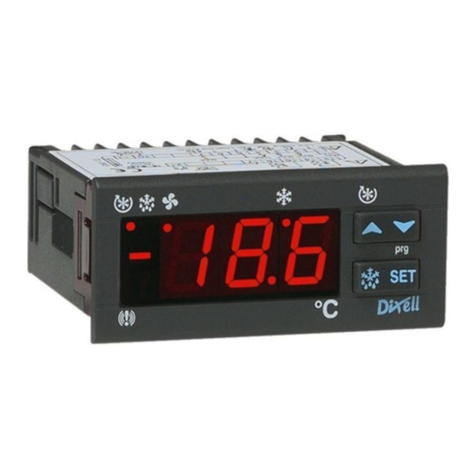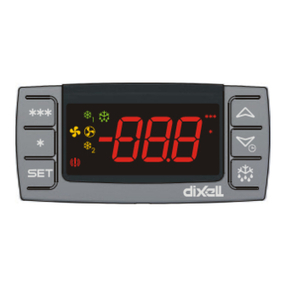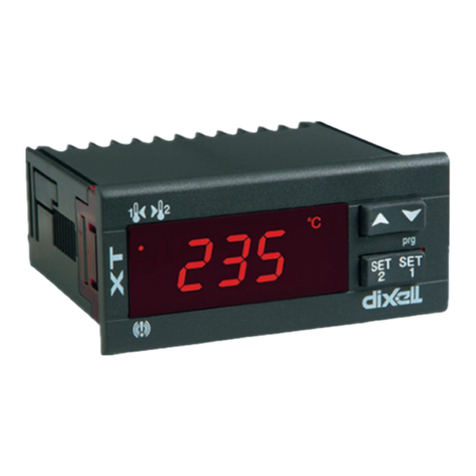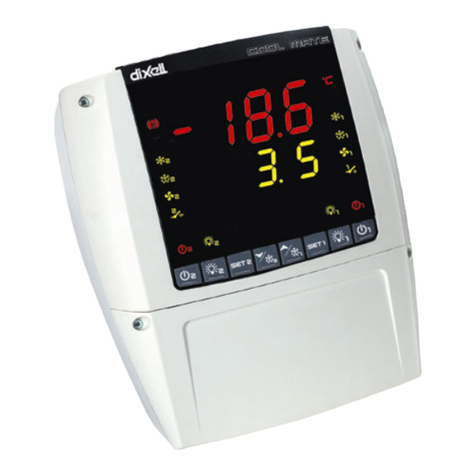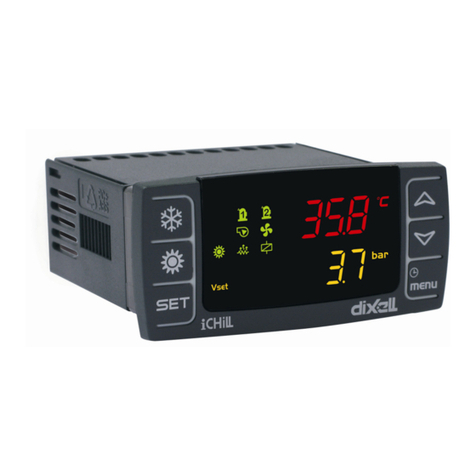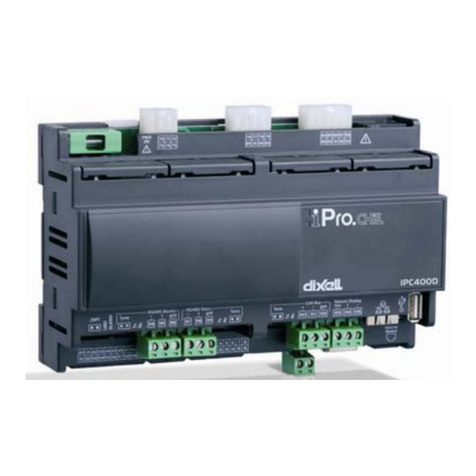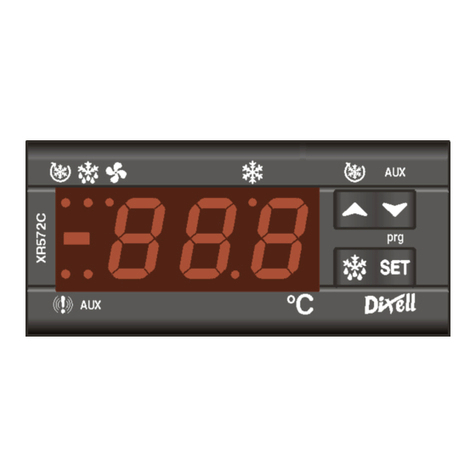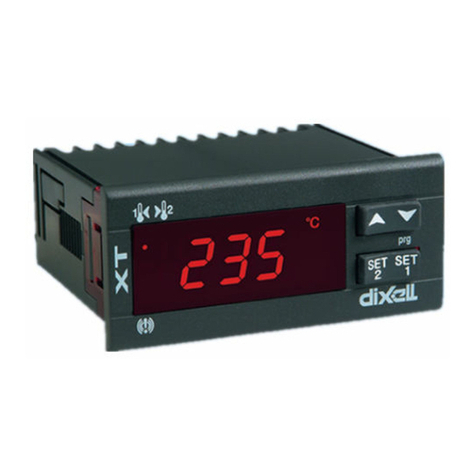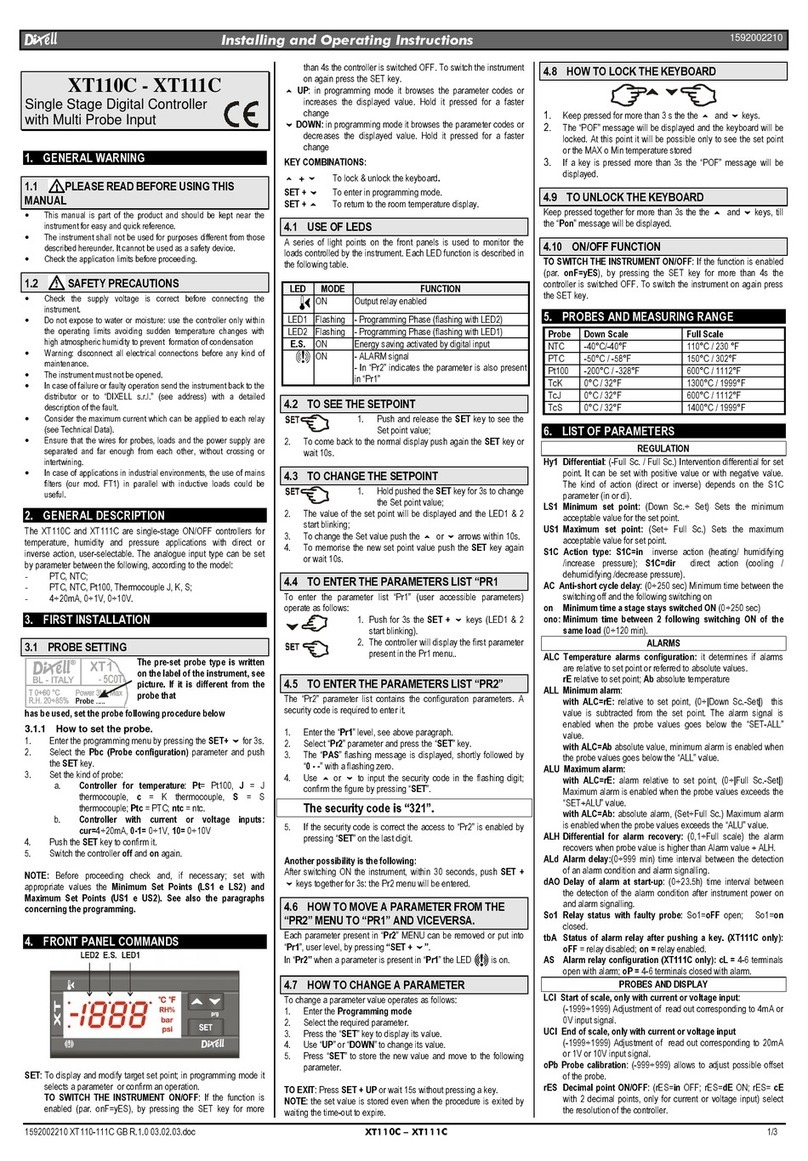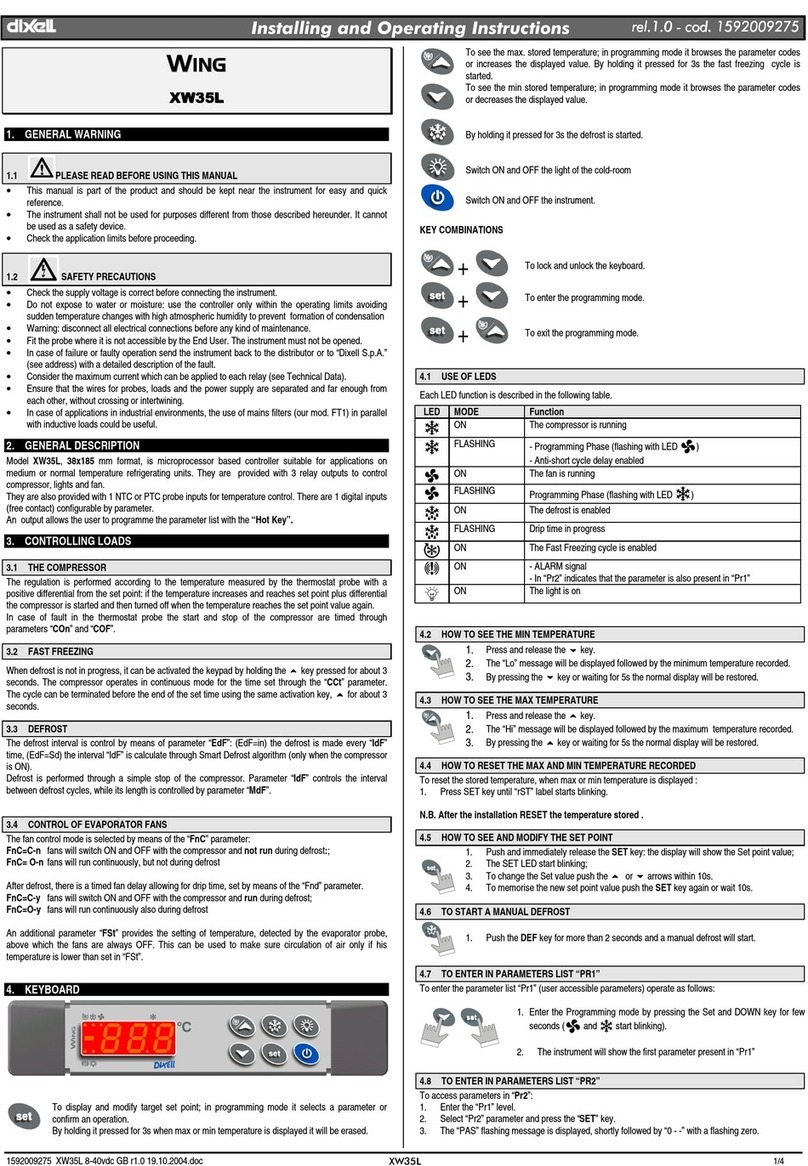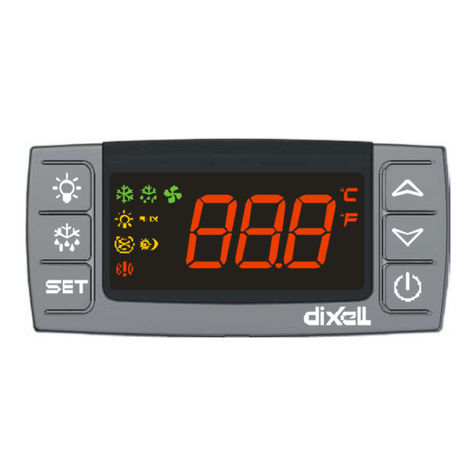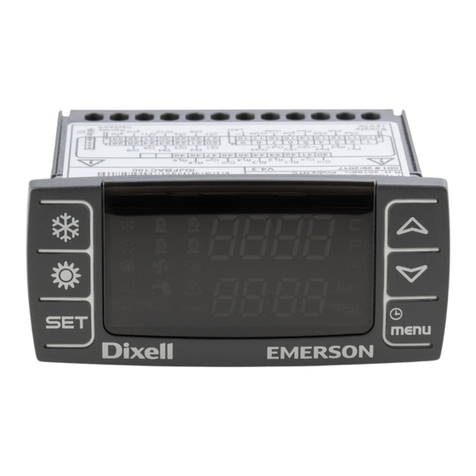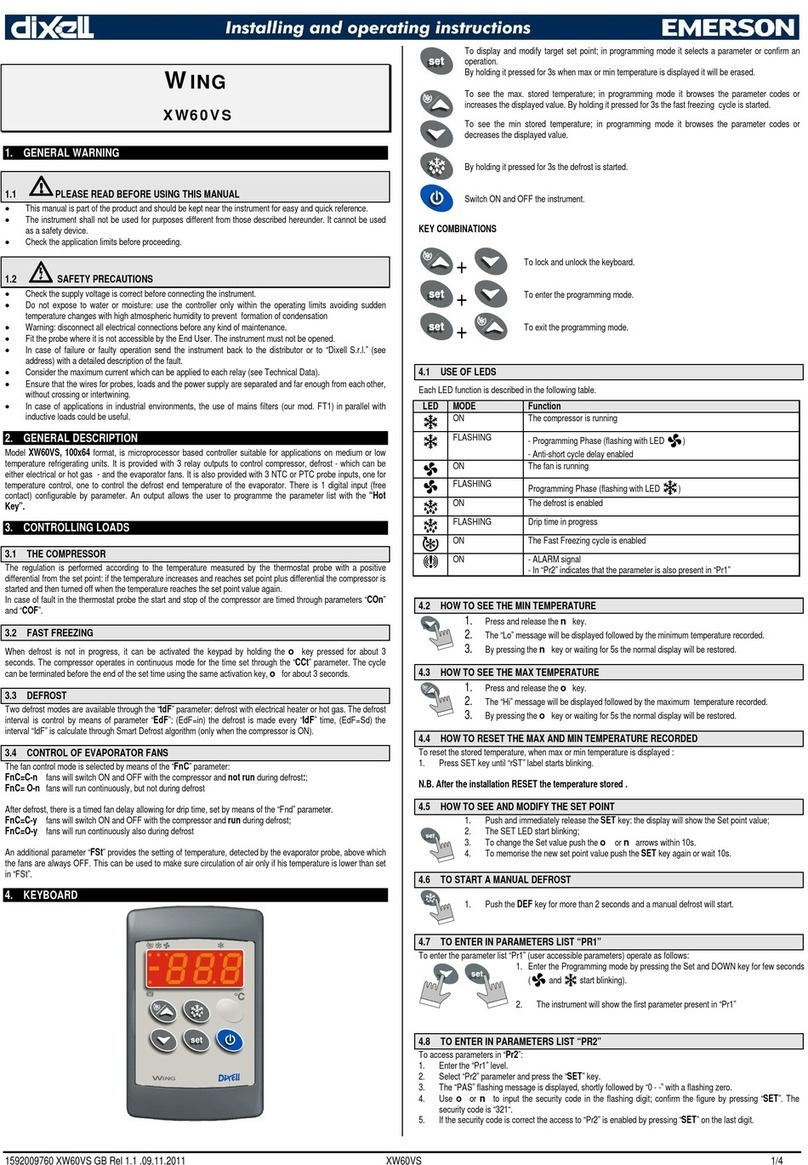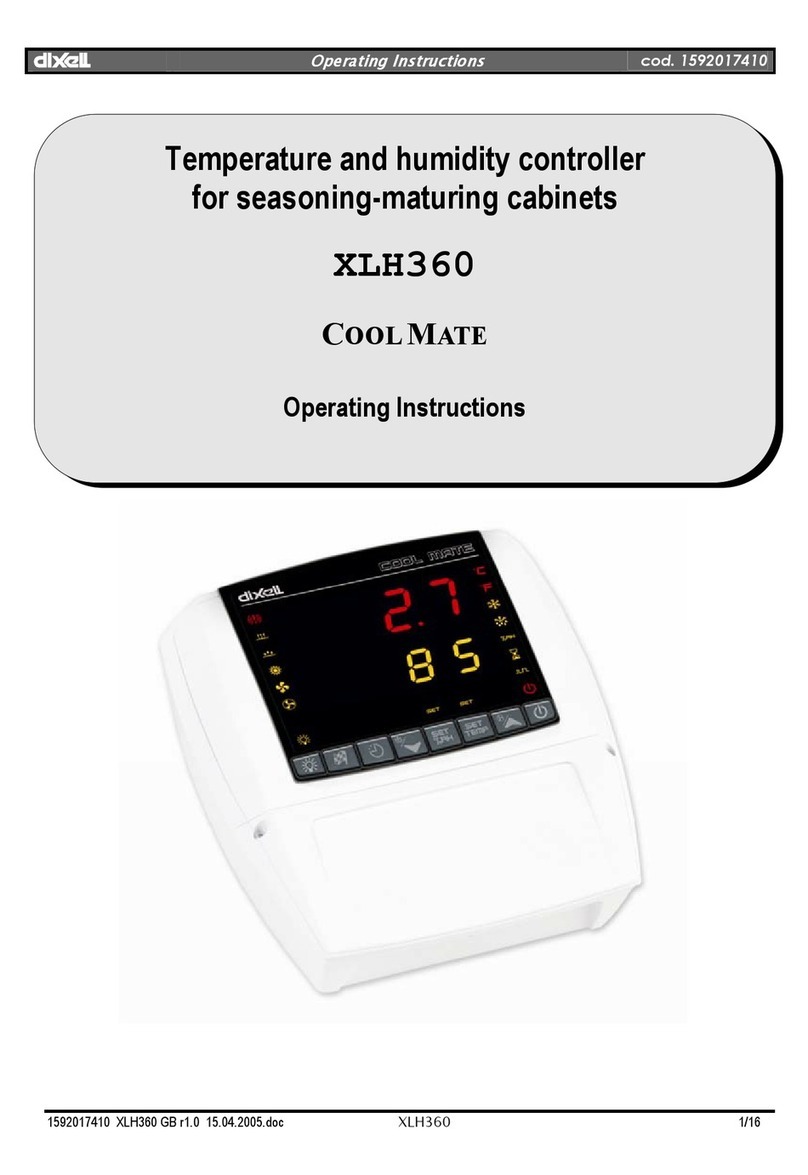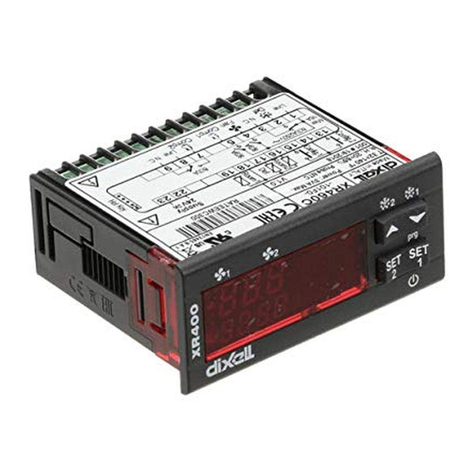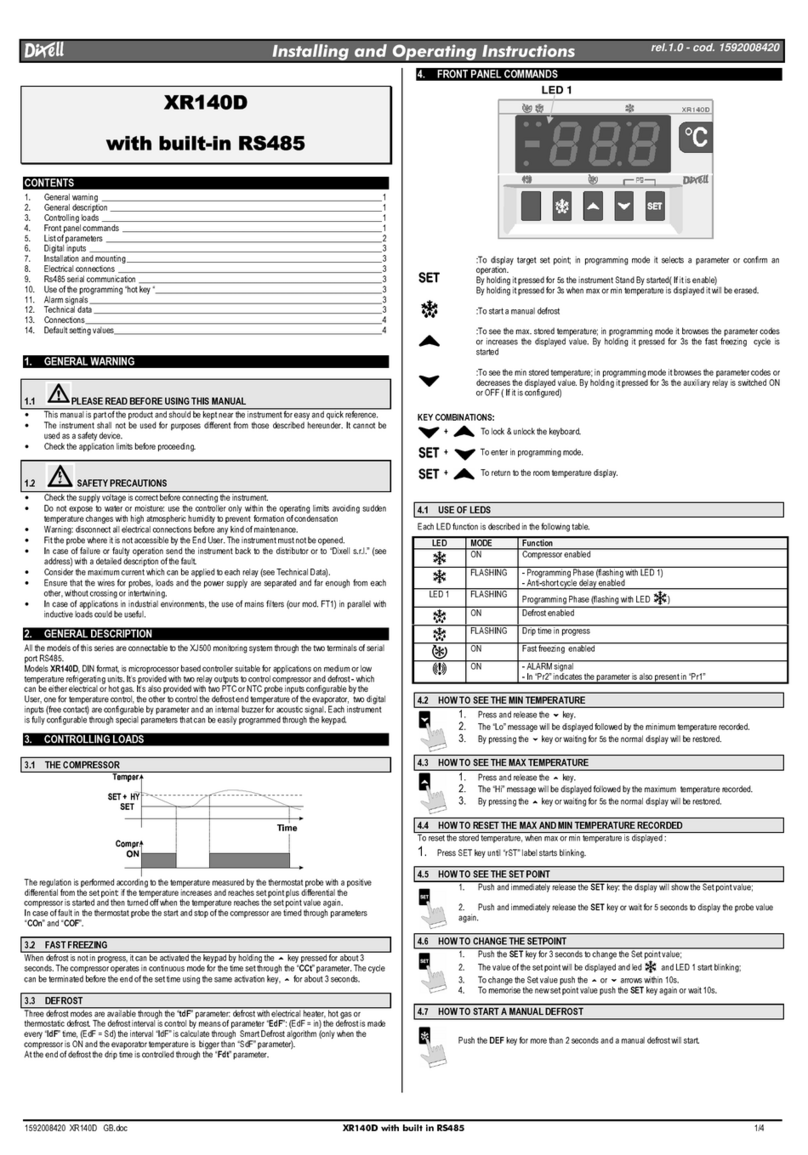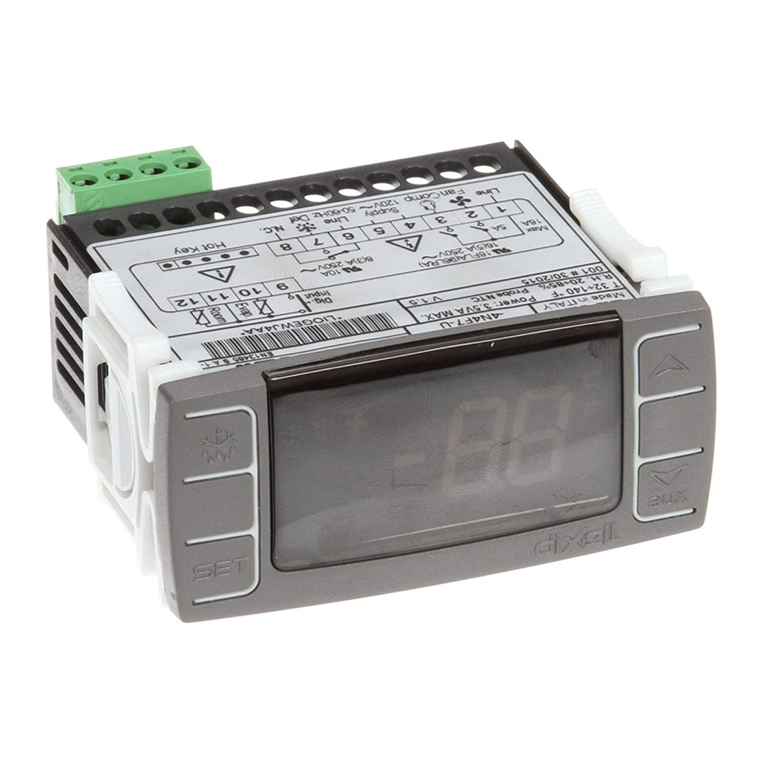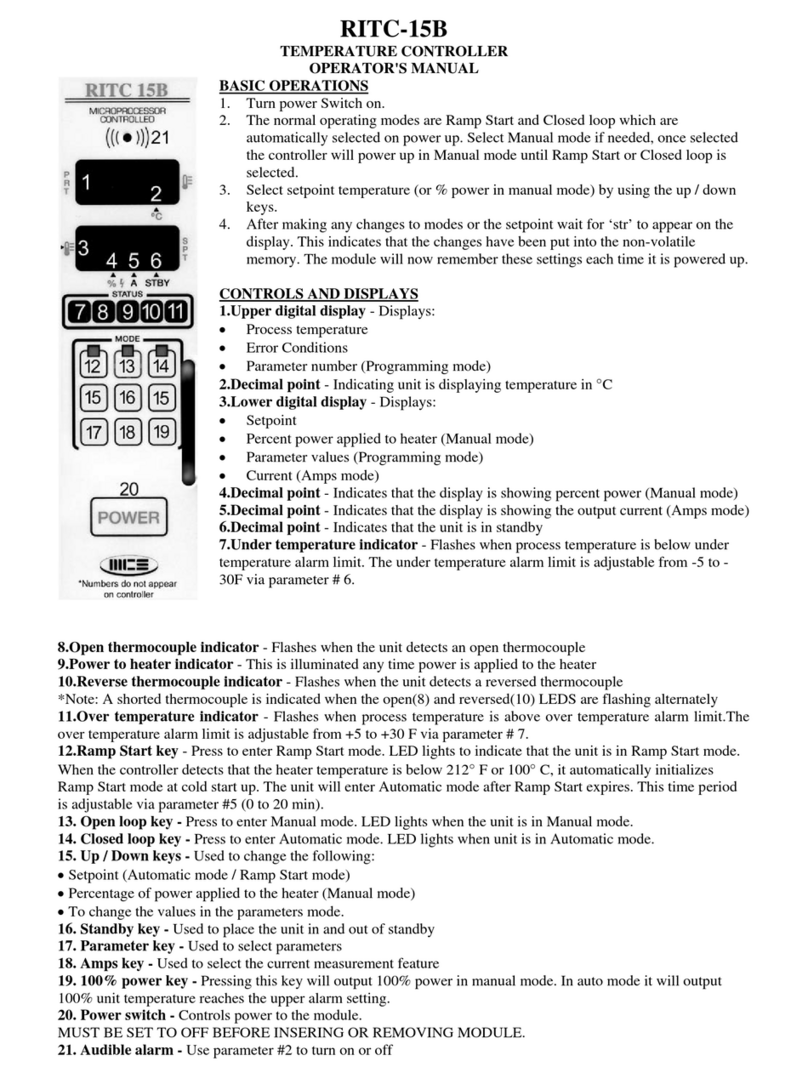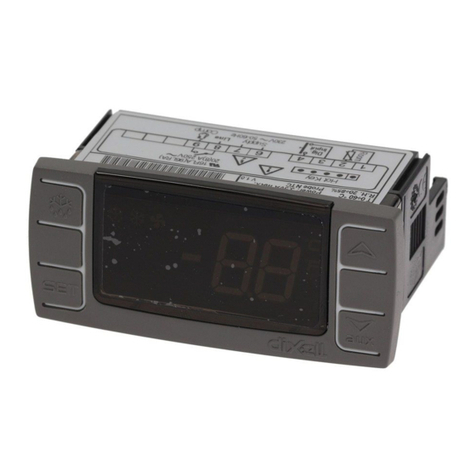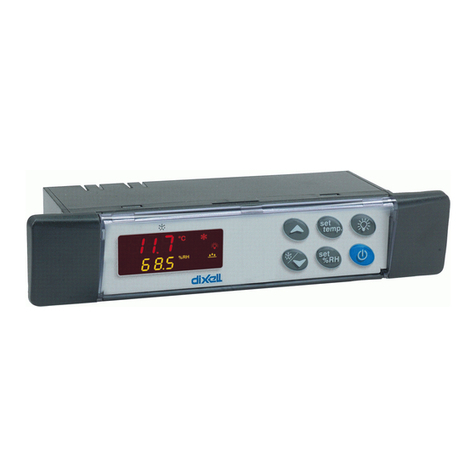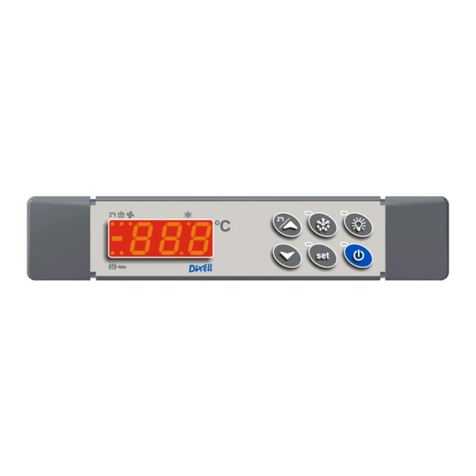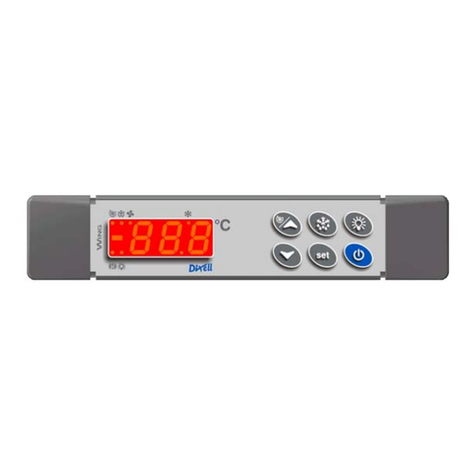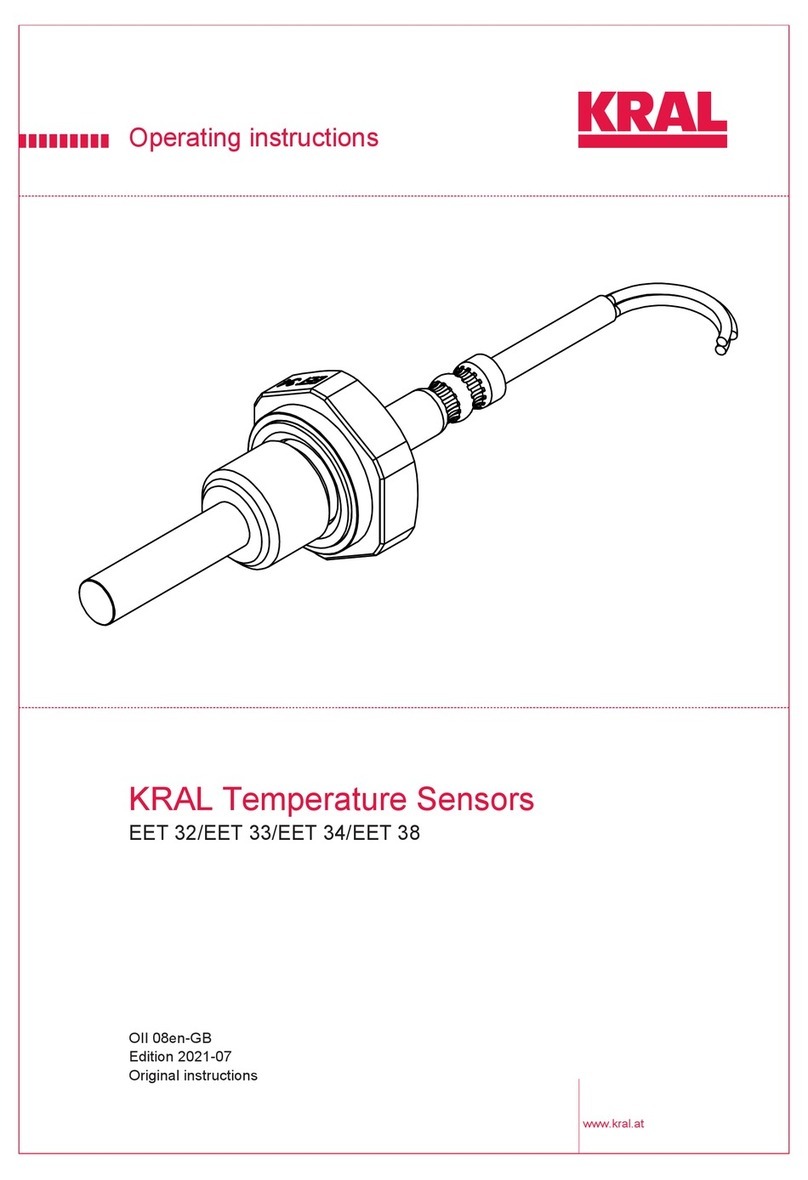
dIXEL
Installing and Operating Instructions
1592018230
1592018230 XW460L-V GB r1.0 04.07.2005.doc r 1.0 * XW460L/XW460V 3/4
dAo1 Delay of temperature alarm at start-up, section 1: (0min÷23h 50min) time interval between
the detection of the temperature alarm condition in section after the instrument power on and
the alarm signalling.
ALc2 Temperature alarms configuration, section 2: it determines if alarms are relative to set point
2 or referred to absolute values: rE relative to set point; Ab absolute temperature.
ALu2 Maximum alarm, section 2: with ALc2=rE: alarm relative to set point1, (0÷50°C) Maximum
alarm is enabled when the probe values exceeds the “SET2+ALU” value. with ALc2=Ab:
absolute alarm, (Set2÷Full Sc.) Maximum alarm is enabled when the probe values exceeds the
“ALu” value.
ALL2 Minimum alarm, section 2: With ALc2=rE: relative to set point1, (0÷50°C) this value is
subtracted from the set point2. The alarm signal is enabled when the probe values goes below
the “SET2-ALL” value. With ALc2=Ab absolute value, minimum alarm is enabled when the
probe values goes below the “ALL2” value.
ALd2 Temperature alarm delay, section 2: (0÷255 min) time interval between the detection of an
alarm condition and the corresponding alarm signalling.
dAo2 Delay of temperature alarm at start-up, section 2: (0min÷23h 50min) time interval between
the detection of the temperature alarm condition in section after the instrument power on and
the alarm signalling.
AFH Temperature alarm and fan differential: (0,1÷25,5°C; 1÷45°F) Intervention differential for
temperature alarm set point and fan regulation set point, always positive.
EdA Alarm delay at the end of defrost: (0÷255 min) Time interval between the detection of the
temperature alarm condition at the end of defrost and the alarm signalling.
dot Delay of temperature alarm after closing the door : (0÷255 min) Time delay to signal the
temperature alarm condition after closing the door.
doA Open door alarm delay:(0÷255 min) delay between the detection of the open door condition
and its alarm signalling: the flashing message “dA” is displayed.
PROBE INPUTS
Pbc Kind of probe: Ptc = PTC; ntc = NTC
oFS1 Thermostat1 probe calibration: (-12.0÷12.0°C/ -21÷21°F) allows to adjust possible offset of
the thermostat1 probe.
oFS2 Thermostat2 probe calibration: (-12.0÷12.0°C/ -21÷21°F) allows to adjust possible offset of
the thermostat2 probe.
oFS3 Evaporator probe calibration: (-12.0÷12.0°C/ -21÷21°F) allows to adjust possible offsets of
the evaporator probe.
P2P Thermostat2 probe presence: no= not present; yES= present.
P3P Evaporator probe presence: no= not present: the defrost stops only by time; yES= present:
the defrost stops by temperature and time.
DIGITAL INPUTS
i2P Digital input polarity: cL : the digital input is activated by closing the contact; OP : the digital
input is activated by opening the contact.
i2F Digital input operating mode: configure the digital input function: MP1 = door switch 1; MP2 =
door switch 2, MP: door switch (it’s used by both the sections); EA1 = generic alarm section 1;
EA2 = generic alarm section 2; EAL = generic alarm (it’s used by both the sections); bA1 =
serious alarm mode section 1; bA2 = serious alarm mode section 2; , bAL = serious alarm
mode section (it’s used by both the sections); dF1 = Start defrost, section 1; dF2 = Start
defrost, section 2; dEF = Start defrost (it’s used by both the sections); oF1 = remote on/ off,
section1; oF2 = remote on/ off, section 2; oFF = = remote on/ off (it’s used by both the
sections); ES = Energy Saving
odc1 Compressor and fan status when open door, section 1: no = normal; Fan = Fan OFF; CPr
= Compressor OFF; F_C = Compressor and fan OFF.
rrd1 Outputs restart after door open alarm, section 1: n = status of outputs according to odc1;
Y= outputs restart working.
did1 Time interval delay for digital input alarm, section 1:(0÷255 min.) With i1F or i2F = EAL1 or
bAL1 (external alarms), “did” parameter defines the time delay between the detection and the
successive signalling of the alarm.
odc2 Compressor status when open door, section 2: no ,Fan = normal;; CPr, F_C = Compressor
OFF.
rrd2 Outputs restart after door open alarm, section 2: n = status of outputs according to odc2;
Y= outputs restart working.
did2 Time interval delay for digital input alarm, section 2:(0÷255 min.) With i1F or i2F = EAL1 or
bAL1 (external alarms), “did” parameter defines the time delay between the detection and the
successive signalling of the alarm.
OTHER
HES1 Temperature increase during the Energy Saving cycle, section 1: (-30÷30°C / -54÷54°F)
sets the increasing value of the set point1 during the Energy Saving cycle.
HES2 Temperature increase during the Energy Saving cycle, section 2: (-30÷30°C / -54÷54°F)
sets the increasing value of the set point2 during the Energy Saving cycle.
Adr1/2 RS485 serial address, section 1/2 (1÷247): Identifies section 1/2 address when connected to
a ModBUS compatible monitoring system.
dP1 First probe display; dP2 Second probe display; dP3 Third probe display;
rEL Release software: (read only) Software version of the microprocessor.
Ptb Parameter table: (read only) it shows the original code of the dIXEL parameter map.
Pr2 Access to the protected parameter list (read only).
8. DIGITAL INPUT
The instrument can support up to 2 free contact digital inputs. Both of them can be configured as One is
always configured as door switch, the second is programmable in seven different configurations by the
“I2F” parameter.
8.1 DOOR SWITCH INPUT (MP1, MP2, MP)
It signals the door status to the controller: MP1: door open for section 1; MP2: door open for section
2; MP door open for both the sections.
When the door is open the status of compressor (and fans) depends on the “odc1” and
“odc2”parameters: no = normal (no changes); Fan = Fan OFF (if fan is present); CPr = Compressor
OFF; F_C = Compressor and fan OFF. Since the door is opened, after the delay time set through
parameter “doA”, the alarm output is enabled and the display shows the message “dA”. The alarm
stops as soon as the external digital input is disabled again. During this time and then for the delay
“dot” after closing the door, the high and low temperature alarms are disabled.
8.2 CONFIGURABLE INPUT - GENERIC ALARM (EA1, EA2, EAL)
It signals to the controller: EA1: generic alarm – section 1; EA2: generic alarm – section 2; EAL:
generic alarm – it counts for both the sections. As soon as the digital input is activated the unit will wait
for “did1” time for section 1 and “did2” time for section 2 delay before signalling the “EAL” alarm
message. The outputs status don’t change. The alarm stops just after the digital input is de-activated.
8.3 CONFIGURABLE INPUT - SERIOUS ALARM MODE (BA1, BA2, BAL)
It signals to the controller: bA1: serious alarm – section 1; bA2: serious alarm – section 2; bAL: serious
alarm – it counts for both the sections. As soon as the digital input is activated the unit will wait for
“did1” time for section 1 and “did2” time for section 2 delay before signalling the “bAL” alarm message.
The relay outputs are switched OFF. The alarm will stop as soon as the digital input is de-activated.
8.4 CONFIGURABLE INPUT - START DEFROST (DF1, DF2, DEF)
It executes a defrost if there are the right conditions, respectively for: dF1: section 1; dF2: section 2;
dEF: both the sections. After the defrost is finished, the normal regulation will restart only if the digital
input is disabled otherwise the instrument will wait until the “Mdf1” and “MdF2” safety time is expired.
8.5 CONFIGURABLE INPUT - REMOTE ON/OFF (OF1, OF2, ONF)
This function allows to switch ON and OFF a sections of the instrument or the whole instrument
according to the following setting: oF1: section 1; oF2: section 2; onF: it counts for both the sections.
When the digital input is de-activated, the corresponding section restarts working.
8.6 CONFIGURABLE INPUT - ENERGY SAVING (i2F=ES)
The Energy Saving function allows to change the set point value as the result of the SET1+HES1 for
section and SET2 + HES2 fro section 2. This function is enabled until the digital input is activated.
8.7 DIGITAL INPUTS POLARITY
The digital inputs polarity depends on “I1P” and “I2P” parameters. CL : the digital input is activated by
closing the contact. OP : the digital input is activated by opening the contact
9. ELECTRICAL CONNECTIONS
The instrument are provided with screw terminal block to connect cables with a cross section up to 2,5
mm2. Heat-resistant cables have to be used. Before connecting cables make sure the power supply
complies with the instrument’s requirements. Separate the probe cables from the power supply cables,
from the outputs and the power connections. Do not exceed the maximum current allowed on each
relay, in case of heavier loads use a suitable external relay.
9.1 PROBE CONNECTION
The probes shall be mounted with the bulb upwards to prevent damages due to casual liquid infiltration.
It is recommended to place probe away from air streams to correctly measure the average room
temperature.
10. SERIAL LINE
The optional RS485 output allows the unit to connect to a network line ModBUS-RTU compatible as the
dIXEL monitoring system.
11. USE OF THE PROGRAMMING “HOT KEY “
The unit can UPLOAD or DOWNLOAD the parameter list from its own E2 internal memory to the “Hot
Key” and vice-versa.
11.1 DOWNLOAD FROM THE “HOT KEY” TO THE INSTRUMENT)
1. Turn OFF the instrument, insert the “Hot Key” and then turn the instrument ON.
2. Automatically the parameter list of the “Hot Key” is downloaded into the memory, the “doL”
message is blinking. After 10 seconds the instrument will restart working with the new
parameters.
3. Turn OFF the instrument remove the “Hot Key”, plug in the TTL serial cable, then turn it ON
again.
At the end of the data transfer phase the instrument displays the following messages: “end “ for right
programming. The instrument starts regularly with the new programming. “err” for failed programming.
In this case turn the unit off and then on if you want to restart the download again or remove the “Hot
key” to abort the operation.
11.2 UPLOAD (FROM THE INSTRUMENT TO THE “HOT KEY”)
1. When the unit is ON, insert the “Hot key” and push èkey; the "uPL" message appears.
2. Push “SET” key to start the UPLOAD; the “uPL” message is blinking.
3. Turn OFF the instrument remove the “Hot Key”, plug in the TTL serial cable, then turn it ON
again.
At the end of the data transfer phase the instrument displays the following messages: “end “ for right
programming. “err” for failed programming. In this case push “SET” key if you want to restart the
programming again or remove the not programmed “Hot key”.
12. ALARM SIGNALS
Message Cause Outputs
“P1” Thermostat1 probe failure Alarm output ON; Compressor1 output according to
parameters “COn1” and “COF1”
“P2” Thermostat2 probe failure Alarm output ON; Compressor2 output according to
parameters “COn1” and “COF2”
“P3” Evaporator probe failure Alarm output ON; Other outputs unchanged
“HA” High temperature alarm Outputs unchanged
“LA” Low temperature alarm Outputs unchanged
“EE” Some memory problems Alarm output ON; Other outputs OFF
“dA” Door switch alarm Outputs unchanged
“EAL” External alarm Outputs unchanged
“bAL” Serious external alarm Regulation outputs deactivated
“POF” Keyboard locked Outputs unchanged
“POn” Keyboard unlocked Outputs unchanged
The alarm message is displayed until the alarm condition is recovery. All the alarm messages are
showed alternating with the room temperature except for the “P1” which is flashing. To reset the “EE”
alarm and restart the normal functioning press any key, the “rSt” message is displayed for about 3s.
12.1 SILENCING BUZZER
Once the alarm signal is detected the buzzer can be silenced by pressing any key.
12.2 “EE” ALARM
The dIXEL instruments are provided with an internal check for the data integrity. Alarm “EE” flashes
when a failure in the memory data occurs. In such cases the alarm output is enabled.
